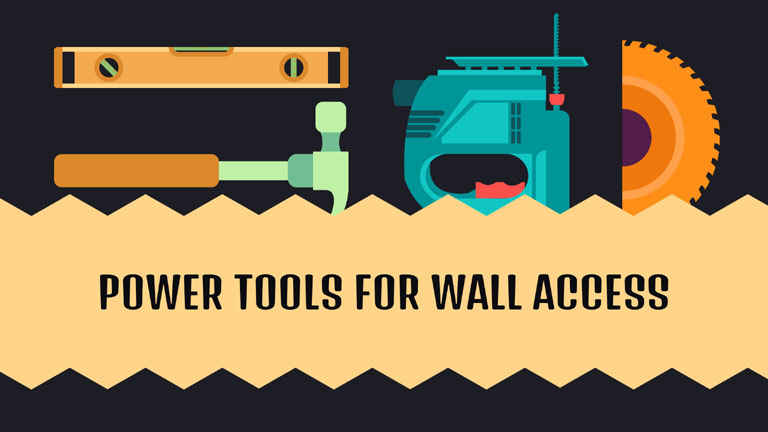What are the best power tools for wall access? Installing access doors and panels is a process that requires tools and equipment. Like most installation processes, it is safer, more efficient, and saves more time when instruments are involved. However, it might be challenging for those new to this type of work because the various machines or devices may be confusing.
Take installing wall access doors and panels as an example. It may be an easy task for a well-seasoned contractor, but it may take longer and riskier for someone new to the field. Knowledge and experience are a requirement, and if you don’t have those in handling such tools, at least you can arm yourself with the proper understanding of what they do and how you can utilize them.
Here are some power tools for wall access you might need when installing wall access doors and panels:
#1. Power Saw
The usual type of saw utilized for wall access doors and panels installation is the reciprocating saw. Reciprocating saws have a blade that cuts material using a push-and-pull movement. These saws’ edges are similar to jigsaw blades in that they are both extensive and toothed, with a long nose and grip at the end of the instrument.
You can typically see these saws in action on construction sites for repairing or renovation projects. If your project has a unique requirement, you can adjust the power tool with accessories such as smaller blades or clamps.
#2. Power Sanders
Because sanding eliminates dents, marks, and other faults from an object, it may be a requirement for installing your access doors and panels, especially if you need it for aesthetics. You can utilize various sanders; however, an orbital sander works better when installing a wall access door or panel.
Orbital sanders are specialized sanding tools with a bright sanding surface. As the name suggests, this sander has a circular form and works in a rotational movement. Powering this instrument is an electric motor that spins at a rapid rate. The sanding disk moves in a circular motion, enabling access to corners and edges easier.
Orbital sanders are helpful for a wide range of projects, particularly those requiring gentle sanding. It aids in preparing a surface before refinishing, painting, or sealing. It is impossible to complete the project’s exterior area without orbital sanders, which is why most people refer to them as “finish sanders.”
#3. Hammer Drill
Every tool collector’s most important tool is a power drill. You can utilize this instrument for a range of tasks like boring a hole in a wall, attaching screws in hard space, and so on. You can operate it manually or electrically. People also refer to these machines as hammering drills or rotary hammers and utilized for operations that need speed, power, and efficiency.
Hammer drills are faster than standard drills, allowing them to punch holes with greater precision and power. All of this may be accomplished in a short time, avoiding the majority of the delays and challenges.
#4. Impact Driver
This tool is a piece of equipment trusted by workers who need a powerful, effective force. It is more compact and lighter than drill drivers. However, an outer sleeve protects it, making drilling screws and tightening nuts safer. The driver exerts rotational and downward force, which aids in the loosening of nuts and screws.
Impact drivers are more adaptable than hammer drills since they can rotate and drill in and out. On the market, you may get both cordless and corded impact drivers.
#5. Side Grinder
A handheld power tool used for polishing and abrasive cutting is an angle grinder. You may also know this tool as a side grinder or disc grinder. Their intended design is for utilization with stiff abrasive discs. The availability of an adaptable power source has allowed many to use them with a wide range of cutters and attachments.
Angle grinders usually have adjustable protection and a side handle for two-handed use. You can utilize specific angle grinders as sanders, depending on their speed range, by using a sanding disc with a supporting disc or pad. The reinforcing system may have phenolic resin, hard plastic, or medium-hard rubber material composition based on the necessary flexibility.
Other Tools You May Need
These are other tools you might need to consider when installing wall access doors and panels because power tools are not the only equipment you will need to finish the installation. The project may require you to have other necessary equipment to safely and efficiently conduct the task.
- Ladders
- Extension Cords
- Pencils or Markers
- Caulk Gun
- Measuring Tools (Rulers and Steel Tape Measure)
Personal Protective Equipement
If you’re going to undertake an installation project, it is the best consideration to protect yourself first. Safety is paramount when doing such tasks because anything wrong will go wrong. By using these pieces of safety equipment, you are protecting yourself against some hazards allowing you to work more comfortably.
#1. Safety Goggles
While working, the first thing you need to have is suitable protective equipment to keep you safe from particles and dust. Because you’ll be cutting drywall, concrete, or wood, expect the presence of dust particles that will go into your eyes and cause harm. Use some comfy, light protective goggles that will not hinder your visual field for protection. If your mirrors give you headaches while you’re wearing them, switch them out for something more comfortable.
#2. Protective Mask
Inhaling hazardous particulates is harmful to your lungs and can lead to long-term respiratory issues. Always consider wearing a protective mask that is safe and comfortable to use, whether your project is on a large scale or a small one. Those with many filters, especially those designed for chemical fumes, are the best.
#3. Hearing Protector
The gadgets used to mitigate noise-induced hearing loss are known as hearing protectors. Employees subjected to 80 decibels or higher noise levels over an 8-hour work shift must use this equipment to dampen noise energy penetrations and cause damage to the inner ear. Earmuffs (also known as ear defenders) and earplugs are the two most common types of hearing protection.
Earmuffs: The design of this equipment are like a pair of cups and typically of thermoplastics and sponge material. These cups’ outer ends are plastic or steel headbands that fit the external ears.
Ear Plugs: An ear protection device placed into the ear canal to shield users’ ears from high noise levels, water incursion, foreign substances, dust, and strong wind. This device helps prevent hearing loss and tinnitus because they limit sound volume (ringing of the ears).
#4. Gloves
You must wear gloves when there is a risk of damage or skin contact from infectious agents, abrasive, cold, heat, chemicals, or cutting items. Choose leather or heavy padding gloves to prevent abrasion and blunt impact on your fingers, knuckles, and palm. The protection a pair of gloves provide enables its user to work efficiently and safely.
Takeaway
Doing any installation is a massive undertaking for any owner, even if it’s a minor project. If you do not have the experience, knowledge, or confidence to tackle the task, it would be best to consider bringing in a licensed professional. They can provide their expert options, opinions, and above all, peace of mind. Hope these power tools for wall access will not disappoint you.

I love all things tech, and I wear many hats – tech lover, business starter, digital marketer, and blogger. I know the ins and outs of Digital Marketing, SEO, SEM, SMM, and how to generate leads. My goal? Making things simple for you with clear guides and reviews. I stumbled upon WordPress while creating my first business site, and I fell in love with it right away. When I’m not building websites, creating content, or boosting clients’ online efforts, I’m focused on staying healthy, hanging out with family, and exploring the world. Connect with me on Facebook, Twitter, Linkedin, or read my complete biography.

